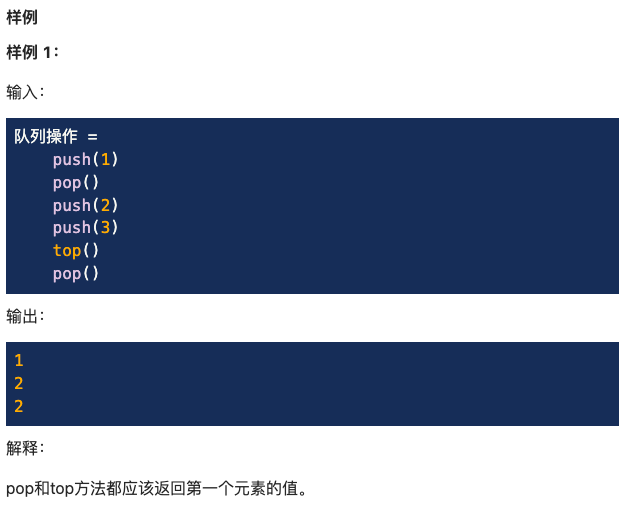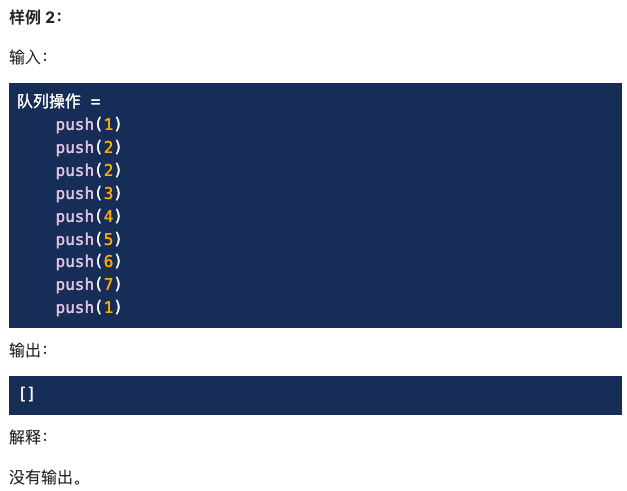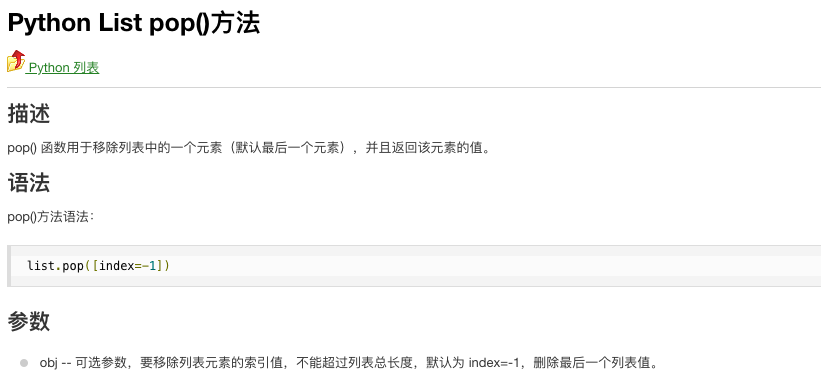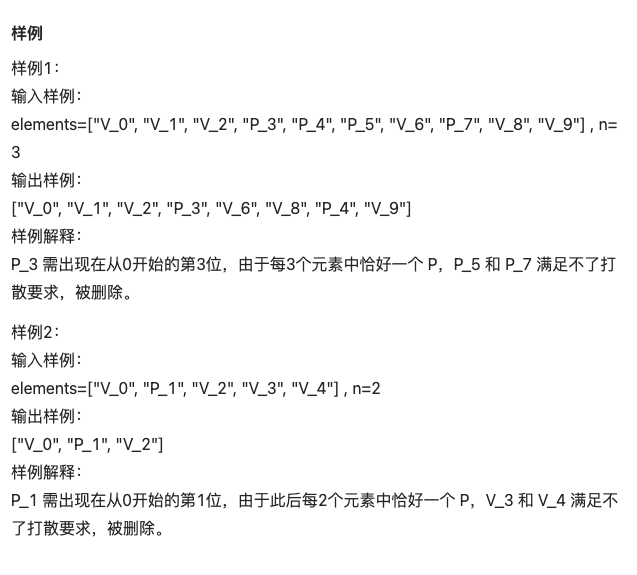40. Implement queue with stack
As stated in the title, you can only use two stacks to implement some operations of the queue. The queue should support push(element), pop() and top(), where pop is the first (foremost) element in the pop-up queue. Both pop and top methods should return the value of the first element.



class MyQueue:
def __init__(self):
# do intialization if necessary
self.stack1 = []
self.stack2 = []
"""
@param: element: An integer
@return: nothing
"""
def push(self, element):
# write your code here
self.stack1.append(element)
"""
@return: An integer
"""
def pop(self):
# write your code here
if self.stack2:
return self.stack2.pop()
else:
while self.stack1:
self.stack2.append(self.stack1.pop())
return self.stack2.pop()
"""
@return: An integer
"""
def top(self):
# write your code here
if self.stack2:
return self.stack2[-1]
else:
while self.stack1:
self.stack2.append(self.stack1.pop())
return self.stack2[-1]
Here is the official answer, which is similar to what I wrote:
class MyQueue:
def __init__(self):
self.stack1 = []
self.stack2 = []
def stack1_to_stack2(self):
# If stack2 is not empty, do not reverse stack1
if self.stack2:
return
while self.stack1:
self.stack2.append(self.stack1.pop())
def push(self, element):
self.stack1.append(element)
def top(self):
self.stack1_to_stack2()
return self.stack2[-1]
def pop(self):
self.stack1_to_stack2()
return self.stack2.pop()
493 · maintenance queue II
Queue is realized through linked list. Provide the following basic methods:
- push_front(item). Adds a new item to the front of the queue.
- push_back(item). Add a new item to the back of the queue.
- pop_front(). Remove the first item from the queue and return it.
- pop_back(). Remove the last item from the queue and return it.

I wrote for an hour, but I didn't write it out
class ListNode():
def __init__(self, val=None):
self.val = val
self.next = None
class Dequeue:
def __init__(self):
# do intialization if necessary
self.beforehead = self.tail = ListNode(-1)
"""
@param: item: An integer
@return: nothing
"""
def push_front(self, item):
# write your code here
self.tail.next = ListNode(item)
self.beforetail = self.tail
self.tail = self.tail.next
"""
@param: item: An integer
@return: nothing
"""
def push_back(self, item):
# write your code here
node = ListNode(item)
node.next = self.beforehead.next
self.beforehead.next = node
self.tail = self.tail.next
"""
@return: An integer
"""
def pop_front(self):
# write your code here
tail_val = self.tail.val
self.tail = self.beforetail
self.tail.next = None
return tail_val
"""
@return: An integer
"""
def pop_back(self):
# write your code here
if self.beforehead.next is not None:
head_val = self.beforehead.next.val
self.beforehead.next = self.beforehead.next.next
return head_val
else:
return False
The official answer uses a two-way linked list
class Dequeue(object):
def __init__(self):
# do some intialize if necessary
self.first, self.last = None, None
# @param {int} item an integer
# @return nothing
def push_front(self, item):
# Write yout code here
if self.first is None:
self.first = Node(item)
self.last = self.first
else:
tmp = Node(item)
self.first.prev = tmp
tmp.next = self.first
self.first = tmp
# @param {int} item an integer
# @return nothing
def push_back(self, item):
# Write yout code here
if self.last is None:
self.first = Node(item)
self.last = self.first
else:
tmp = Node(item)
self.last.next = tmp
tmp.prev = self.last
self.last = tmp
# @return an integer
def pop_front(self):
# Write your code here
if self.first is not None:
item = self.first.val
self.first = self.first.next
if self.first is not None:
self.first.prev = None
else:
self.last = None
return item
return -12
# @return an integer
def pop_back(self):
# Write your code here
if self.last is not None:
item = self.last.val
self.last = self.last.prev
if self.last is not None:
self.last.next = None
else:
self.first = None
return item
return -12
class Node():
def __init__(self, _val):
self.next = self.prev = None
self.val = _val
546. Implement queue by interface
Implement queue by interface
The interface class tells you what method to implement. You only need to write the name of the method, that is, the name of the interface in the future.
Then implement specific methods in the following classes.
class InterfaceQueue:
def push(self, element):
pass
# define an interface for pop method
# write your code here
def pop(self):
pass
# define an interface for top method
# write your code here
def top(self):
pass
class MyQueue(InterfaceQueue):
# you can declare your private attributes here
def __init__(self):
# do initialization if necessary
self.before_head = self.tail = ListNode(-1)
# implement the push method
# write your code here
def push(self, val):
self.tail.next = ListNode(val)
self.tail = self.tail.next
# implement the pop method
# write your code here
def pop(self):
if self.before_head.next is not None:
res_val = self.before_head.next.val
self.before_head = self.before_head.next
return res_val
else:
return -1
# implement the top method
# write your code here
def top(self):
return self.before_head.next.val
# Your MyQueue object will be instantiated and called as such:
# MyQueue queue = new MyQueue();
# queue.push(123);
# queue.top(); will return 123;
# queue.pop(); will return 123 and pop the first element in the queue
Notice here, I wrote it at the beginning
Error: self.before_head.next = self.before_head.next.next correct: self.before_head = self.before_head.next
642 · average value of data flow sliding window
Give a string of integer streams and window sizes, and calculate the average value of all integers in the sliding window.

Double ended queue creation method:
import collections d = collections.deque()
import collections
class MovingAverage(object):
"""
@param: size: An integer
"""
def __init__(self, size):
# do intialization if necessary
self.deque = collections.deque()
self.size = size
"""
@param: val: An integer
@return:
"""
def next(self, val):
# write your code here
if len(self.deque) < self.size:
self.deque.append(val)
return sum(self.deque) / len(self.deque)
else:
self.deque.popleft()
self.deque.append(val)
return sum(self.deque) / self.size
# Your MovingAverage object will be instantiated and called as such:
# obj = MovingAverage(size)
# param = obj.next(val)
Here are the official answers:
from collections import deque
class MovingAverage(object):
def __init__(self, size):
self.queue = deque([])
self.size = size
self.sum = 0.0
def next(self, val):
if len(self.queue) == self.size:
self.sum -= self.queue.popleft()
self.sum += val
self.queue.append(val)
return self.sum / len(self.queue)
1166 · recommended results scattered
A recommendation system will recommend a list of video and picture elements. x represents the element number, and V is used for video_ x indicates that the picture is represented by P_x means. Now you need to break up these elements. The rules are as follows:
- The position where the first [picture P] appears remains unchanged;
- Starting from the first [picture P], exactly one [picture P] appears in every n elements;
- The relative order between pictures remains unchanged;
Elements that cannot meet the fragmentation rule need to be discarded. Given the element list and the value of n, please return the scattered element list.

I wrote for a long time, but I didn't write it out
from typing import (
List,
)
class Solution:
"""
@param elements: A list of recommended elements.
@param n: [picture P] can appear at most 1 in every n
@return: Return the scattered result.
"""
def scatter(self, elements: List[str], n: int) -> List[str]:
# write your code here
temp = []
res = []
cur = 0
mark = -100
while cur < len(elements):
index = len(res) - 1
if index == mark:
if temp != []:
res.append(temp.pop(0))
cur += 1
else:
break
if elements[cur][0] == 'V':
if index == mark:
if temp != []:
res.append(temp.pop(0))
cur += 1
else:
break
else:
res.append(elements[cur])
cur += 1
elif elements[cur][0] == 'P':
if mark == -100:
res.append(elements[cur])
mark = index + n
cur += 1
elif index != mark:
temp.append(elements[cur])
cur += 1
elif index == mark:
if temp != []:
res.append(temp.pop(0))
cur += 1
else:
break
return res
Read an answer, use two queue s to store P and V respectively, and then break up according to his rules.
import queue
class Solution:
"""
@param elements: A list of recommended elements.
@param n: [picture P] can appear at most 1 in every n
@return: Return the scattered result.
"""
def scatter(self, elements, n):
# write your code here
# Define double queues to store picture element P and video element V respectively
queueP = queue.Queue()
queueV = queue.Queue()
# Where the first picture P appears
firstP = -1
for i in range(0, len(elements)):
if elements[i][0] == 'P':
# First picture P
if firstP == -1:
firstP = i
# P join the queue
queueP.put(elements[i])
else:
# This element is added to the V queue
queueV.put(elements[i])
# Define the result sequence after fragmentation
result = []
# Store the V element before the first P into the result sequence
while firstP > 0:
firstP -= 1
result.append(queueV.get())
while queueP.empty() == False:
# Exactly one P is required in every n elements
result.append(queueP.get())
# Auxiliary variable
step = n
# Store n-1 V elements into the result sequence
while queueV.empty() == False and step > 1:
result.append(queueV.get())
step -= 1
# If the requirements for breaking up cannot be met at present, it can be ended directly
if step > 1:
break
return result
Another answer is similar:
def scatter(self, elements, n):
# write your code here
q_V = collections.deque()
q_P = collections.deque()
first_p = -1
res = []
for i in range(len(elements)):
if elements[i][0] == "P":
first_p = i
break
res = elements[:first_p]
for i in range(first_p, len(elements)):
if elements[i][0] == "P":
q_P.append(elements[i])
else:
q_V.append(elements[i])
while q_P: # break while loop when q_P is empty
res.append(q_P.popleft())
temp = n
while q_V and temp > 1:
res.append(q_V.popleft())
temp -= 1
if temp > 1: # q_V is empty, break loop, even if q_P is not empty
break
return res